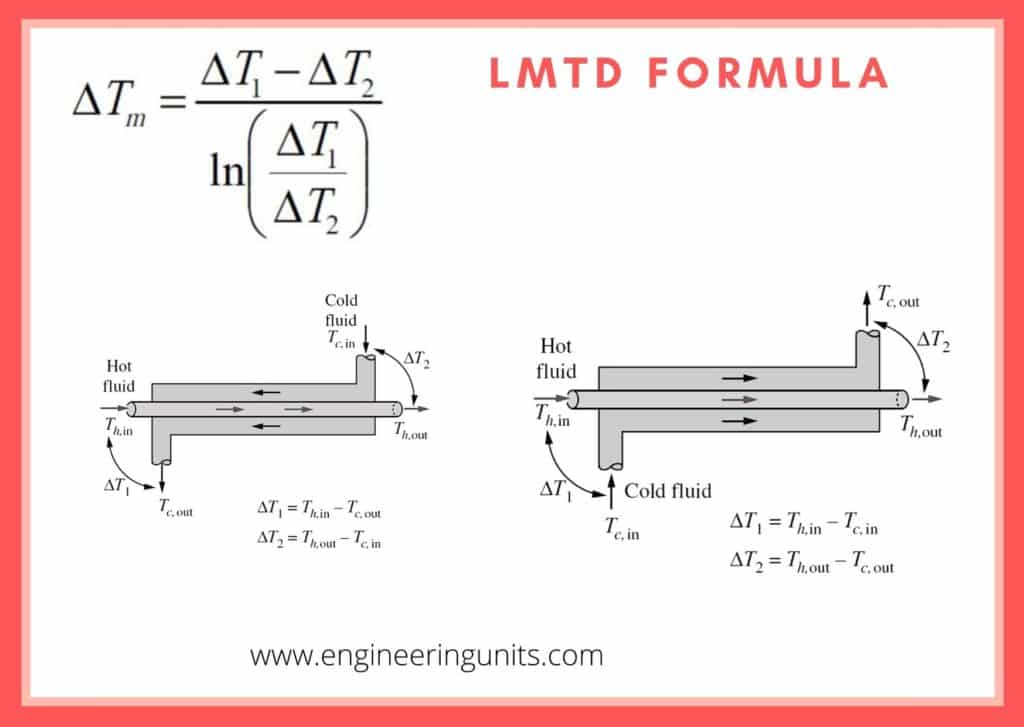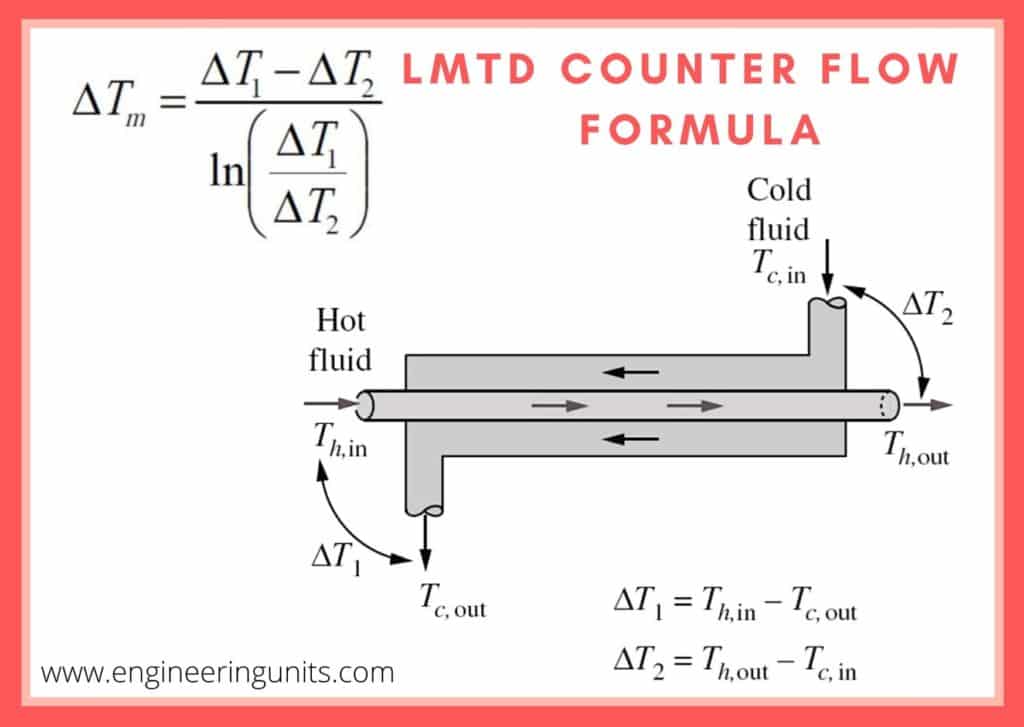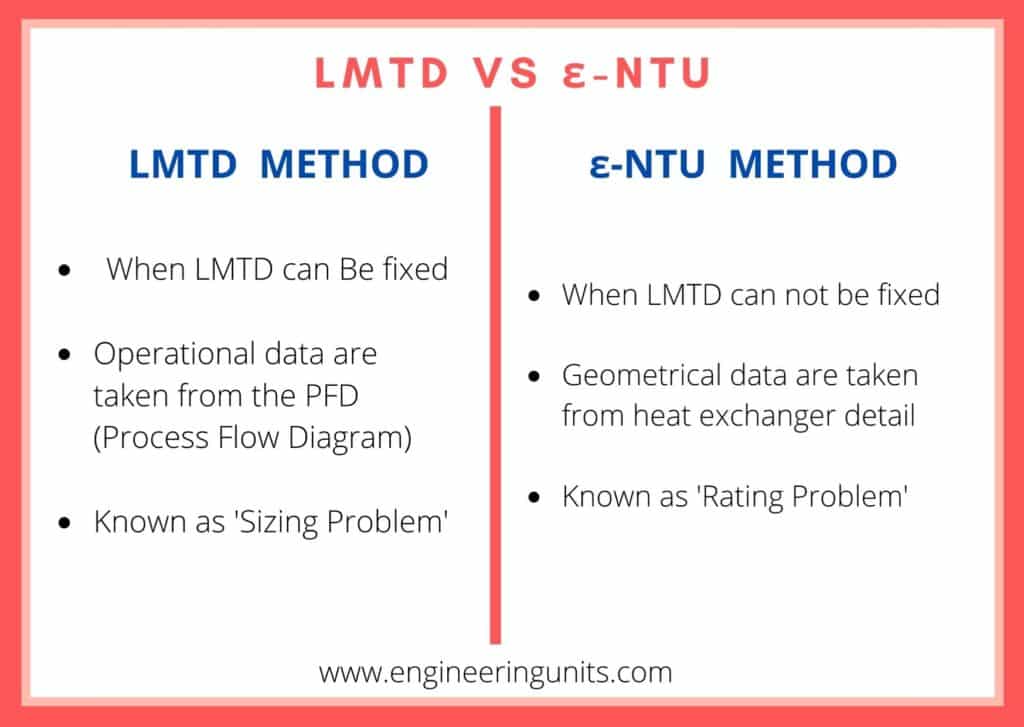Use our online Log Mean Temperature Difference Calculator:
LMTD Formula:
LMTD = [ΔT1- ΔT2]/[lnΔT1 / lnΔT2 ]

where ΔT1 and ΔT2 as defined below for the LMTD counter-current flow and LMTD parallel flow:
LMTD Counter-current flow exchanger

LMTD Parallel flow Exchanger

We used the equations shown above in our calculator Log Mean Temperature Difference Calculator.
Why LMTD Method is used?
Generally, heat exchanger are evaluated by the following methods:
- Effectiveness Number of Transfer Units (ε-NTU) methods. Three-dimensional parameters: Heat Capacity Rate ratio (HCRR), effectiveness and the Number of the transfer.
- Logarithmic Mean Temperature Difference (LMTD). The most commonly known method described in the Tubular Exchanger Manufacturers Association (TEMA).

This section will focus only on why LMTD is used. This method is useful for determining the overall heat transfer coefficient based on the inlet and outlet fluid and the exchange area (Temperature driving force). In another simple word, the LMTD method is preferred when we know the inlet and outlet temperatures of the hot and cold fluids and we do not have phase changes in the fluids.
Mean temperature difference LMTD Vs AMTD
In this section, we will answer the recognizable question why we use LMTD instead of the AMTD and when we can use an AMTD instead of LMTD to avoid the use of the calculator.
If you want to know about how do we come up with the LMTD check the article of Wikipedia.

First lets define the AMTD and the LMTD :
AMTD:
AMTD = ((T1 + T2)- (T3 + T4))/2 = [ΔTinletinlet + ΔToutletoutlet]/2
LMTD:
LMTD = [ΔTinletinlet- ΔToutletoutlet]/[lnΔTinletinlet- lnΔToutletoutlet]
The AMTD introduced with the assumption that the fluid temperature change in the two flows sides of the heat exchanger are small the use of the AMTD is justified. In other word, if there is no significance diffrence between range mean terminal temperature of ΔTinletinlet and ΔToutletoutlet, we can use AMTD
Where the variation between of the temperature within the fluids are large compared with the difference between the entry fluid temperature the use of the LMTD is more appropriate. In other words, if there is a significant difference between range mean terminal temperature of ΔTinletinlet and ΔToutletoutlet, we should use LMTD.
The table and the graph shows the variation of the LMTD and the AMTD for a range mean terminal temperature.
| Δ1 | Δ2 | LMTD | AMTD |
|---|---|---|---|
| 100 | 90 | 94.9 | 95 |
| 100 | 85 | 92.3 | 92.5 |
| 100 | 80 | 89.6 | 90 |
| 100 | 75 | 86.9 | 87.5 |
| 100 | 70 | 84.1 | 85 |
| 100 | 65 | 81.2 | 82.5 |
| 100 | 60 | 78.3 | 80 |
| 100 | 55 | 75.3 | 77.5 |
| 100 | 50 | 72.1 | 75 |
| 100 | 45 | 68.9 | 72.5 |
| 100 | 40 | 65.5 | 70 |
| 100 | 35 | 61.9 | 67.5 |
| 100 | 30 | 58.1 | 65 |
| 100 | 25 | 54.1 | 62.5 |
| 100 | 20 | 49.7 | 60 |
| 100 | 15 | 44.8 | 57.5 |
| 100 | 10 | 39.1 | 55 |
| 100 | 5 | 31.7 | 52.5 |

From this graph we can conclude that if the difference of mean terminal temperature of ΔTinletinlet and ΔToutletoutlet is greater than 50% we should use LMTD.
AMTD is used mainly for field engineering or as rule of thumb to come up with a quick and a gross estimation of Q = U X A X AMTD.
To avoid to choose between AMTD and LMTD you can use per default our Log Mean Temperature Difference Calculator.
Reference: